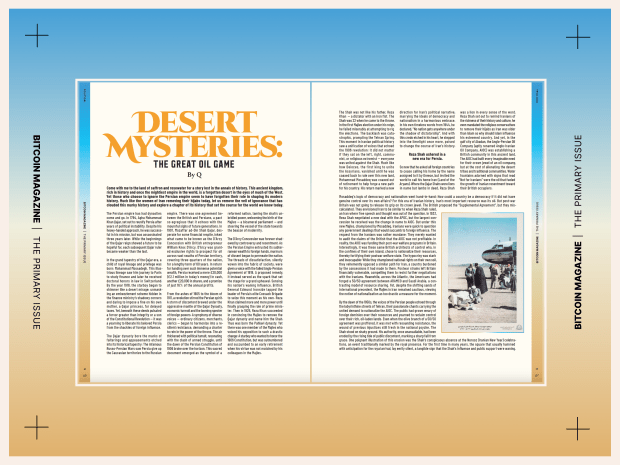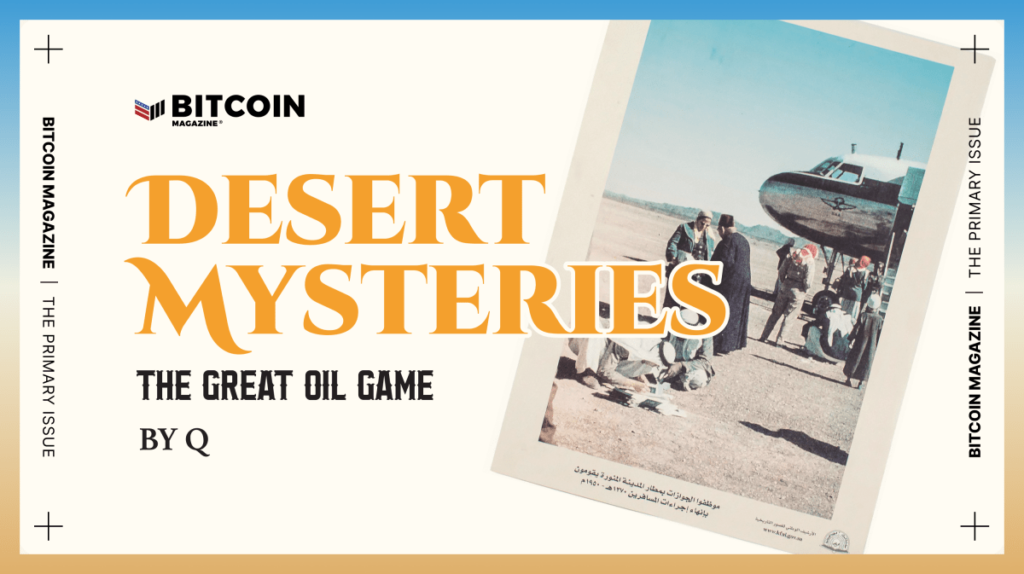This article is featured in Bitcoin Magazine’s “The Primary Issue”. Click here to get your Annual Bitcoin Magazine Subscription.
Click here to download a PDF of this article.
Come with me to the land of saffron and rosewater for a story lost in the annals of history. This ancient kingdom, rich in history and once the mightiest empire in the world, is a forgotten desert in the eyes of much of the West. Yet those who choose to ignore the Persian empire seem to have forgotten their role in shaping its modern history. Much like the women of Iran removing their hijabs today, let us remove the veil of ignorance that has clouded this murky history and explore a chapter of its history that set the course for the world we know today.
The Persian empire has had dynasties come and go. In 1794, Agha Mohammad Khan Qajar, set out to reunify Persia after years of political instability. Despite his heavy-handed approach, he was successful in his mission, but was assassinated three years later. While the beginnings of the Qajar reign showed a future to be hopeful for, each subsequent Qajar ruler became weaker than the last.
In the grand tapestry of the Qajar era, a child of royal lineage and privilege was born: Mohammad Mossadegh. This illustrious lineage saw him journey to Paris to study finance and later he received doctoral honors in law in Switzerland. By the year 1918, the starboy began to shimmer like a desert mirage: unmasking an embezzlement scheme hidden in the finance ministry’s shadowy corners and daring to impose a fine on his own mother, a Qajar princess, for delayed taxes. Yet, beneath these deeds pulsated a fervor greater than integrity or a son of the Constitutional Revolution — it was a yearning to liberate his beloved Persia from the shackles of foreign influence.
The Qajar dynasty bore the marks of falterings and appeasements etched into its historical tapestry: The infamous Russo-Persian Wars saw Persia give up the Caucasian territories to the Russian empire. There was one agreement between the British and Persians, a pact so egregious that it echoes with the mournful sighs of future generations. In 1901, Mozaffar ad-Din Shah Qajar, desperate for some financial respite, inked what came to be known as the D’Arcy Concession with British entrepreneur William Knox D’Arcy. D’Arcy was granted exclusive rights to prospect for oil across vast swaths of Persian territory, covering three-quarters of the nation, for a lengthy term of 60 years. In return for handing over such immense potential wealth, Persia received a mere £20,000 (£2.1 million in today’s money) in cash, another £20,000 in shares, and a promise of just 16% of the annual profits.

From the ashes of 1905 to the bloom of 1911, a revolution stirred the Persian spirit. A storm of discontent brewed under the oppressive mantle of the Qajar Dynasty, economic turmoil and the looming specter of foreign powers. A symphony of diverse voices — ordinary citizens, merchants, clerics — began to harmonize into a resilient resistance, demanding a charter to rein in the power of the throne. The air thickened with political tumult, resonating with the clash of armed struggle, until the dawn of the Persian Constitution of 1906 broke over the horizon. This sacred document emerged as the symbol of a reformed nation, taming the shah’s unbridled power, welcoming the birth of the Majles — a bicameral parliament — and steering the vessel of the state towards the beacon of modernity.
The D’Arcy Concession was forever shadowed by controversy and resentment. As the Persian Empire entrusted its subterranean wealth to foreign hands, murmurs of dissent began to permeate the nation. The threads of dissatisfaction, silently woven into the fabric of society, were given a voice with the failed Anglo-Persian Agreement of 1919. A proposed remedy, it instead served as the spark that set the stage for a grand upheaval. Sensing his nation’s waning influence, British General Edmund Ironside tapped the leader of Persia’s elite Cossack Brigade to seize this moment as his own. Reza Khan claimed more and more power until finally grasping the role of prime minister. Then in 1925, Reza Khan succeeded in convincing the Majles to remove the Qajar dynasty and name him the Shah. Thus was born the Pahlavi dynasty. Yet there was one member of the Majles who voiced his opposition to such a drastic change: A starboy who wanted to honor the 1906 Constitution, but was outnumbered and succumbed to an early retirement when his virtue was not matched by his colleagues in the Majles.
The Shah was not like his father, Reza Khan — a dictator with an iron fist. The Shah was 22 when he came to the throne. In the first Majles election under his reign, he failed miserably at attempting to rig the elections. The backlash was catastrophic, prompting the Tehran Spring. This moment in Iranian political history saw a unification of voices that echoed the 1906 revolution: It did not matter if they sat on the left, right, communist, or religious extremist — everyone was united against the Shah. Much like how Deioces, the first king to unite the Assyrians, vanished until he was coaxed back to rule over this new land, Mohammad Mosaddeq was coaxed out of retirement to help forge a new path for his country. His return marked a new direction for Iran’s political narrative, marrying the ideals of democracy and nationalism in a harmonious embrace. In his own timeless words from 1944, he declared, “No nation gets anywhere under the shadow of dictatorship”. And with this credo etched in his heart, he stepped into the limelight once more, poised to change the course of Iran’s history.
Reza Shah ushered in a new era for Persia. So new that he asked all foreign countries to cease calling his home by the name assigned to it by Greece, but invited the world to call his home Iran (Land of the Aryans). Where the Qajar Shahs were lions in name but lambs in deed, Reza Shah was a lion in every sense of the word. Reza Shah set out to remind Iranians of the richness of their history and culture, he even mandated the religious conservatives to remove their hijabs as Iran was older than Islam so why should Islam influence his esteemed country. And yet, in the gulf city of Abadan, the Anglo-Persian Oil Company (aptly renamed Anglo-Iranian Oil Company, AIOC) was establishing a British community in this ancient land. The AIOC had built every imaginable need for their crown jewel of an oil company, but at the cost of alienating the desert tribes and traditional communities. Water fountains adorned with signs that read “Not for Iranians” were the oil that fueled the growth of Iranian resentment toward their British occupiers.
Mosaddeq’s logic of democracy and nationalism went hand-in-hand: how could a country be a democracy if it did not have genuine control over its own affairs? For this era of Iranian history, Iran’s most important resource was its oil. But post-war Britain was not going to release its grip on its crown jewel. The British proposed the “Supplemental Agreement”, but they miscalculated. They envisioned Iran to be similar to when Reza Shah ruled, an Iran where free speech and thought was out of the question. In 1933, Reza Shah negotiated a new deal with the APOC, but the largest concession he received was the change in name to AIOC. But under this new Majles, championed by Mosaddeq, Iranians were quick to question any government dealings that would succumb to foreign influence. The request from the Iranians was rather mundane: They merely wanted to audit the claims of the British that the AIOC was not profitable. In reality, the AIOC was funding their post-war welfare programs in Britain. Interestingly, it was these same British architects of control who, in the confines of their own island, chose to nationalize their resources, thereby fortifying their postwar welfare state. The hypocrisy was stark and inescapable: While they championed national rights on their own soil, they vehemently opposed a similar path for Iran, a country burdened by the concessions it had made to them. Postwar strains left Britain financially vulnerable, compelling them to resist further negotiations with the Iranians. Meanwhile, across the Atlantic, the Americans had forged a 50/50 agreement between ARAMCO and Saudi Arabia, a contrasting model of resource sharing. Yet, despite the shifting sands of international precedent, the Majles in Iran remained cautious, viewing the notion of nationalization as too drastic a measure for the moment.
By the dawn of the 1950s, the voices of the Persian people echoed through the labyrinthine streets of Tehran, their passionate chants carrying the united demand to nationalize the AIOC. The public had grown weary of foreign dominion over their resources and yearned to reclaim control over their rich, oil-laden lands. Even when the olive branch of a 50/50 agreement was proffered, it was met with resounding resistance, the wound of previous injustices still fresh in the national psyche. The Shah stood on shaky ground. His authority, once unassailable, had been eroded by the rising tide of public discontent, marking a sharp fall from grace. One poignant illustration of this erosion was the Shah’s conspicuous absence at the Norooz (Iranian New Year) celebrations, an event traditionally marked by the royal presence. For the first time in many years, the square that usually hummed with anticipation for the royal arrival, lay eerily silent, a tangible sign that the Shah’s influence and public support were waning.
As winter thawed into spring in 1951, a unanimous wave of agreement swept through the Majles on March 15. This defining moment led to a political fallout — the Prime Minister, Hossein Ala, felt the chill of exclusion as he was bypassed in the strategic decision-making of the nine-step plan to nationalize the AIOC, triggering his abrupt resignation. In the ensuing vacuum of power, the Shah’s nominee, Zia ed-Din Tabatabai, was presented to the Majles, only to be met with a firm rejection. The Majles flexed its democratic muscles and cast its vote overwhelmingly in favor of Mohammad Mosaddeq, 79 to 12, pushing him onto center stage. Backed into a corner, the Shah was left with no alternative but to reluctantly bestow the mantle of Prime Minister onto Mosaddeq, his most detested adversary. Instead of looking to the elder Mosaddeq as an advisor — he was 69 when elected prime minister — the Shah feared Mosaddeq until his death. Consequently, the British found their worst Iranian nemesis at the helm of Persian politics, a fact that would send ripples through the fabric of the Empire.
In the searing summer of 1951, Mosaddeq, often compared to the venerable ancients Cyrus and Darius, came forth as the liberator of his people. Wielding power like a finely balanced sword, Mosaddeq echoed the pacifist resolve of Gandhi and the rebellious spirit of Hugo Chávez. His ascendancy was a bitter pill for the British to swallow, who watched helplessly as their worst Iranian nemesis enacted a sweeping expropriation of the AIOC, or as he provocatively called it, “the former company”.
His audacious move gave birth to an economic deadlock that felt like a protracted game of chicken, with the U.S. blinking first under the stern gaze of Mosaddeq and the increasingly vocal Iranians. Truman, fearing the simmering rise of communism in a strife-ridden Iran, urged negotiation, effectively validating the nationalization of the AIOC. The British, however, responded with an air of imperial disdain, and even their veiled threats of a militaristic Plan Y were quelled by U.S. intelligence reporting on Mosaddeq’s near-unanimous support among his people.
Unyielding negotiations and the adamant British refusal to recognize the principle of nationalization led to severe sanctions on Iran, precipitating its decline into an economic abyss. In the face of this international embargo, a weakened Iran faced the British at the UN, with Mosaddeq eloquently defending his nation’s aspirations. His triumph was so profound that the Security Council was left with no choice but to defer the debate, sparing the British further humiliation.
Even after this monumental victory, the principle of nationalization remained a sore point in the negotiations. Despite Mosaddeq’s openness to resuming discussions, the newly empowered Conservative Party under Churchill remained obstinate. Mossadeq, ever the statesman, recognized that this wasn’t just about oil or economic deals, but a struggle for the very soul of a nation.
Amid this high-stakes drama, the global stage cast its spotlight on Mosaddeq, making him Time’s “Man of the Year” for 1951 Yet the British, undeterred, continued to undermine him, even as the Iranian people rallied around their leader, ready to defend their rights and their resources to the end. In their hearts, they knew that this fight for their homeland, for their very identity, was indeed their finest hour.
In the swirling chaos of Iranian politics, not all were in alignment with Mossadeq. As the quality of life deteriorated, resentments bubbled to the surface, and fingers were pointed at Mossadeq, seeing in him a puppet of the West. The communists, in particular, held him in their crosshairs.
The British did their best to subvert Mosaddeq, even going as far as instigating riots during the next Majles election. A request for military control from the Shah by Mossadeq further stoked the flames of discord, but was met with refusal. Mossadeq, in an act of protest, submitted his resignation, only to be reinstated after his successor’s tenure crumbled in just five days. Fearful whispers spread that Mossadeq aspired to the presidency or perhaps the throne, but the principled leader maintained his stance; a monarch should reign, and a prime minister should rule.
Enter Fazlollah Zahedi, a loyal servant of the Pahlavi dynasty, an officer dismissed by Mossadeq for an overly violent crackdown of protestors, but with deep ties to anti-communism. In his quest to dislodge Mossadeq, Zahedi skillfully played the game of allegiance, managing to turn some of Mossadeq’s closest allies against him. The key figure that Zahedi would manipulate was Ayatollah Abol Qasem Kashani who had supported Mosaddeq’s nationalization plan, but was wavering over fear of growing Western influence in Iran. Meanwhile, Mossadeq, feeling the pressure, severed diplomatic ties with Britain, ordering the closure of their embassy and the expulsion of all British officials.
During this diplomatic tussle, Dwight D. Eisenhower was elected President of the United States, promising to take a hard line against communism. Seizing this moment, Britain presented Operation Boot to the U.S., hinting at the communist threat from Iran. British intelligence painted a grim picture of Mossadeq’s Iran — a nation on the brink of chaos, a fertile ground for Soviet influence.
Skepticism met these initial reports in Washington, with the local CIA station chief warning of an Anglo-colonial scent to the scheme. Yet, the relentless anti-communist fervor of Allen Dulles, the new director of CIA, prevailed. Despite a thorough analysis suggesting that Mossadeq was not a communist, and that his nationalization agenda enjoyed almost universal Iranian support, the Eisenhower administration green-lit Operation Boot.
A torrent of propaganda was unleashed against Mossadeq, depicting him as everything from a communist sympathizer to an atheist. CIA operatives infiltrated various layers of Iranian society, hiring the Rashidian brothers and sowing the seeds of dissent, pushing important figures into active opposition against the government. Meanwhile, Mossadeq remained blissfully ignorant of this covert assault, clinging to his faith in American goodwill. He wrote to President Eisenhower asking for a loan or the right to sell Iranian oil to the U.S. By the time Mosaddeq received his rejection letter from President Eisenhower, a quiet American was on his way to Tehran.

The stage was set for the CIA’s covert coup, dubbed Operation Ajax, with Kermit Roosevelt Jr. at the helm. In a four-pronged attack aimed at destabilizing Mossadeq’s rule, the plan involved a vigorous propaganda campaign, inciting riots and disturbances, securing the cooperation of military officers, and finally, facilitating the Shah to dismiss Mossadeq and appoint Zahedi as his replacement. The final point was the most challenging, but after receiving assurances that he would be out of Tehran and granted asylum should the coup fail, the Shah signed two farmans (imperial decrees), one dismissing Mosaddeq and one naming General Zahedi as Prime Minister.
However, the coup met with initial failure. Mossadeq’s chief of staff had been tipped off, and the Shah, fearing for his life, fled to Iraq. Yet, the relentless Roosevelt, undeterred by this setback, orchestrated a masterstroke of misinformation. Mass-produced copies of the Shah’s signed farmans were spread across Tehran, turning public sentiment against Mossadeq. Despite the story of the failed attempt on his life that Mosaddeq shared on the radio, the Iranian people began to question their Prime Minister and wondered if he in fact was the one orchestrating a coup.
In the final act of this grand political theater, paid mobs of Iranian wrestlers paraded the streets of Tehran, first as communists supporting Mossadeq, and later as nationalists defending the Shah. This culminated in violent clashes at Mossadeq’s home on August 19, 1953, resulting in 300 deaths and the successful execution of the coup. Many of the dead “patriots” had 500-rial notes in their pockets; the price of their loyalty, handed out by the CIA.
The aftermath was a mixed bag. Britain, the initial instigator, was humbled in the international arena, and the only five-years-old CIA catapulted into stardom with its first win and a playbook they would reuse for decades to come. In the world of petropolitics, it was the United States that had the last laugh. A new deal saw control of Iranian oil divided between Britain and a consortium of American companies, with billions of dollars flowing into American coffers over the next 25 years. Iran would also reap the rewards of this tidal wave, but it was never the same.
Such is the tumultuous tale of power and intrigue that unfolded between Iran, Britain, and the United States. The Shah, restored to his throne, ruled with an iron fist backed by American support. The brief flicker of democracy in Iran was smothered under his monarchy, paving the way for the Islamic Revolution of 1979, which still shapes the region’s geopolitical landscape today.
Eisenhower’s administration, triumphant, set the stage for Operation Ajax to be a play used and reused for foreign policy. The CIA now had the success to point to when engaging in foreign policy around the world: A tactic that would be repeated in many corners of the world with varying degrees of success and often regrettable consequences.
Once the unrivaled guardians of Iran’s oil bounty, the British were compelled to divide the spoils with their transatlantic allies. The concession was not just a sharing of material wealth, but also a surrender of prestige, a palpable testament to their receding clout in a world increasingly tipped in America’s favor. As a desperate attempt to retain a semblance of their former power, they rebranded the Anglo-Iranian Oil Company as British Petroleum. They remained in the game, their chess pieces still in play but demoted from kings and queens to mere pawns. Their dominance had been replaced by a subtle servitude, their power once absolute, now shared.
Mossadeq, the once-celebrated leader of Iran, was left a fallen hero. Accused of treason, he was sentenced to three years in prison and lifelong house arrest. He refused the Shah’s pardon, holding steadfast to his belief in Iranian sovereignty until his last breath.
Meanwhile, the innocent people of Iran, who had once held hope for a future shaped by their own hands, found themselves caught in a storm of international power politics. Their aspirations for democracy were doused by the ambitions of world powers, their rich, ancient land reduced to a mere battleground of Cold War rivalries.
And thus, the chapters of history unfolded, a saga of imperial ambitions, covert operations, and the struggle for sovereignty. The story of the 1953 coup is etched in the annals of global politics, a poignant reminder of the consequences when the games of power override the principles of justice, self-determination, and respect for national sovereignty.
Editor’s Note: All facts were taken from the book America and Iran: A History, 1720 to the Present by John Ghazvinian from pages 1-206.
This article is featured in Bitcoin Magazine’s “The Primary Issue”. Click here to get your Annual Bitcoin Magazine Subscription.
Click here to download a PDF of this article.









Comments are closed.